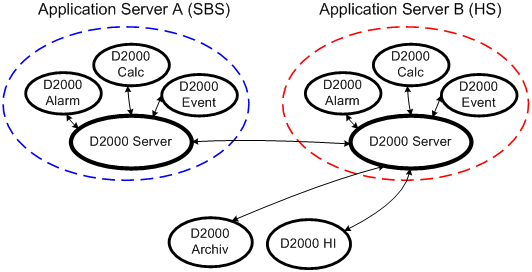Redundancy of application server
For such an application, the D2000 system consists of two or several application servers (processes D2000 Server).
The following figure shows D2000 system with two application servers (A and B):
Redundant system consists of one or several application servers. The servers form so called Redundant group (RDG) which has configurationally assigned name. Each of the application servers can be in different states. In ordinary circumstances (during the standard operation), there is one server in the state HOT Server (HS) and the others are in the state STANDBY Server (SBS). HS is active and as the only one performs all tasks resulting from its configuration. All SBS servers check the presence of the HS and they are connected to the HS as client processes. Process name is the same as server name with the suffix KNL in the RDG. The HS keeps all SBS servers informed about changes in the configuration and the current values of all objects included in the configuration. Therefore, each of the SBS servers is capable of taking over the HS function at any moment.
For such a configuration of redundant system, there are several methods for connecting clients to application server.
- Direct connection to application server - process is started without parameters, if it is placed on the same computer as the server, or using the parameter /S from a remote computer. When the process is connected successfully, it is informed about the current state of the server. If the server is HS, the process activity is not limited in any way and the process keeps its functionality according to the process type. If the server is SBS, the process activity is limited by its type (see the chapter Activity of processes within RDG).
- RDG connection - process is started with the parameter /RD (or /RF) along with the RDG name. The information is used by the process, when looking for the HS of the given RDG. After making a connection, the process begins to operate.
Some other properties of RDG :
- In every moment, there is just one Server active, so-called Hot Server (HS). The other members of RDG are in the SBS state.
- All computers with running RDG members must be available to each other by means of MULTICAST messages.
- After unexpected termination of HS or after starting the Server, the RDS members elect a new HS. New HS is selected and the other servers in the SBS state will be automatically restarted.
- During operation, the configuration database of every RDG member is kept synchronized with the HS configuration.
- After starting a new RDG member, before changing into the state SBS, its configuration database is automatically fully synchronized with the configuration database of the current HS.
- Server started as a RDG member keeps testing its connection to the network and visibility of defined computers using the service PING. If none of the computers responds, the server will be automatically stopped.
- Server status can be changed into the HS state if its priority is greater than 0 and the parameter State in the list of RDG parameters is set to SBS.
- Request to switch the server to the HS state if the server is in other state than SBS will terminate it.

Pridať komentár